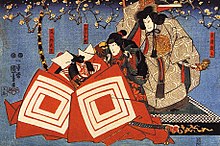Shibaraku
| Shibaraku 暫, しばらく |
|
|---|---|

A Shibaraku scene, Utagawa Kuniyoshi
|
|
| Written by | Ichikawa Danjūrō line |
| Characters | Kamakura Gongorō Kagemasa, Kiyohara no Takehira, Prince Kamo Jirō Yoshitsuna, Princess Katsura-no-mae |
| Date premiered | 1697, Nakamura-za, Edo |
| Original language | Japanese |
| Genre | aragoto jidaimono |
| Setting | Tsurugaoka Hachimangū, Kamakura |
Shibaraku (暫, しばらく) is a play in the Kabuki repertoire, and one of the celebrated Kabuki Jūhachiban ("Eighteen Great Plays"). The flamboyantly dramatic costume and makeup (kumadori) used in this scene is famous and associated by the average Westerner with Kabuki in general. The English translation of the title is akin to "Stop a Moment!"
Originally staged by Ichikawa Danjūrō I in 1697 at the Nakamura-za, it was very popular, and quickly began to be included at the annual kaomise celebrations of each theatre in Edo. For a time, the main role was frequently different, depending on the whims of the theatre and the troupe. The piece was standardized somewhat in the early 19th century by Danjūrō VII, and reworked again by Danjūrō IX at the end of that century. This version has been performed since then.
A scene of roughly 50 minutes, Shibaraku is not a play unto itself, but a short drama inserted during interludes or in between full plays to provide variety and maintain a certain level of energy and interest on the part of the audience. Today is played mostly on special occasions, such as to celebrate an actor's name changing ceremony.
Like many other Kabuki plays, the characters and locations changed their names several times across the centuries. The modern version of the drama centers around the figure of Kamakura Gongorō Kagemasa, who has become the stereotypical bombastic hero of the kabuki stage, with red-and-white striped makeup and strong, energetic movement. The historical Kamakura Kagemasa is famous for his bravery for having continued to fight after losing an eye in battle in the Gosannen War (1083–1087).
The story is set in front of the Tsuruoka Hachimangu shrine, where an evil aristocrat (his exact identity changed across the centuries, and in the modern version is the Heian era warlord ) has usurped the power and took as prisoners several imperial loyals, including the prince Kamo Yoshitsuna and the princess Katsura. One of Takehira's henchmen, lady Teruha, tries to persuade him to don't execute them in front of the shrine or he will enrage the gods.
...
Wikipedia
